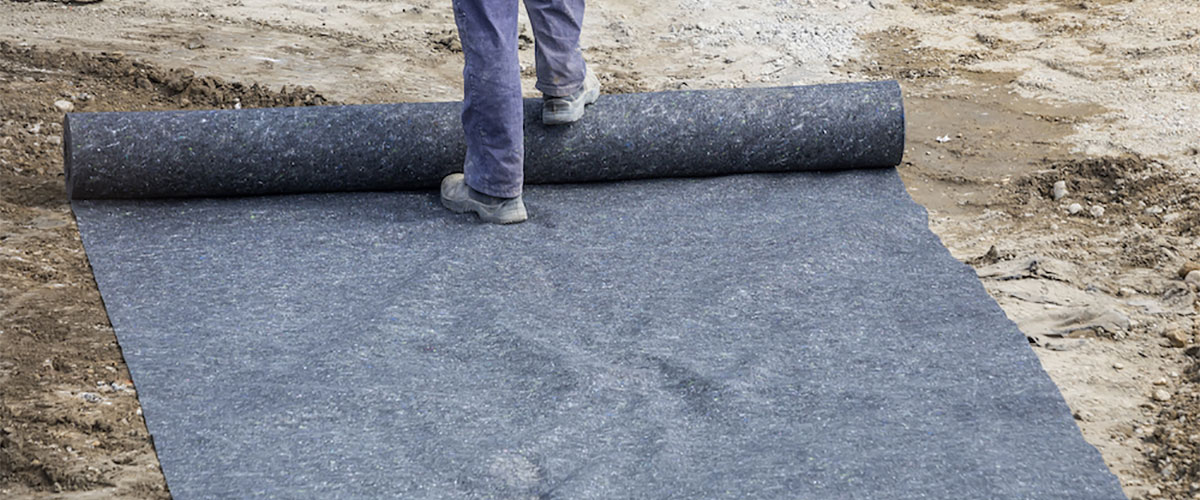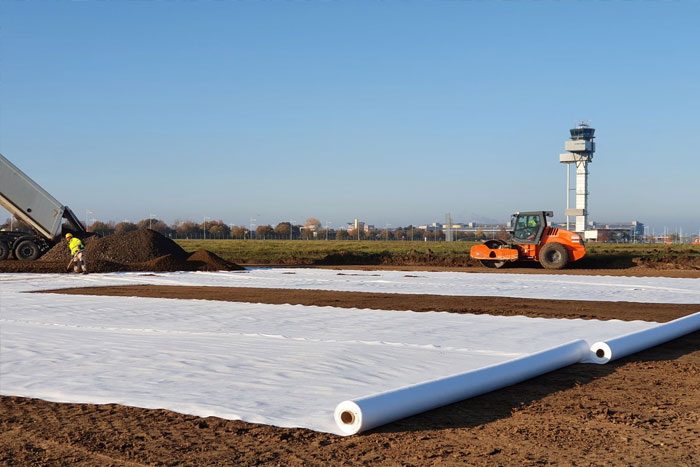
Geotextiles are synthetic or natural fabrics used in civil engineering and environmental projects. They are designed to perform a variety of functions, including filtration, separation, reinforcement, drainage, erosion control, and protection. In this article, we want to discuss what is a geotextile and talk about its applications.
An overview of geotextile history
Geotextiles are geosynthetic products that have been used for thousands of years in various forms, although the modern concept of it, dates back to the mid-twentieth century.
One of the earliest recorded uses of a geotextile is in the construction of the Great Wall of China, which was built over 2,000 years ago. The wall was constructed using layers of compacted earth and stone, with woven reed mats placed between the layers to help distribute the weight of the structure and prevent soil erosion.
In the nineteenth century, materials such as jute and burlap were used as “filter cloths” to help drain water from soils in civil engineering projects. These materials were also used to reinforce earthen structures such as dams.
The modern concept of a geotextile began to emerge in the 1950s and 1960s, with the development of synthetic materials such as polyester and polypropylene. These materials were found to be ideal for use as geotextiles due to their strength, durability, and ability to resist degradation from exposure to sunlight and chemicals.
In the 1970s, it became more widely used in civil engineering projects, particularly in the construction of roads, railways, and embankments. Since then, the use of geotextiles has expanded to include a wide range of applications, including erosion control, landfill and waste containment, coastal protection, and geotechnical engineering.
Read more: What are geocomposite materials ?
What are the different types of geotextiles?
There are several different types of geotextiles, each with its own unique characteristics and properties. Here are some of the most common types of it:
- Woven geotextiles: These are made by weaving individual threads together in a specific pattern. They are strong and durable, with high tensile strength and puncture resistance. They are commonly used in applications that require high strength and stability, such as road and railway construction.
- Nonwoven geotextiles: These are made by bonding fibers or filaments together using heat, pressure, or chemical adhesives. They are typically lighter and more flexible than woven geotextiles, but still offer good strength and filtration properties. They are often used in applications such as erosion control, pavement underlayment, and drainage systems.
- Knitted geotextiles: These are made by interlocking loops of yarns or fibers together. They have good tensile strength and flexibility, making them suitable for use in applications such as soil stabilization, slope protection, and filtration.
- Composite geotextiles: These are made by combining two or more layers of different types of geotextiles, such as a woven layer and a nonwoven layer. They offer the combined properties of their component layers, such as high strength and good filtration.
- Geogrids: These are made of synthetic materials such as polyester or polypropylene, and are designed to provide high tensile strength in one or more directions. They are commonly used in applications such as retaining walls, embankments, and paved roads, where they help distribute loads and prevent soil movement.
What is the raw material for geotextiles?
The raw material for geotextiles can vary depending on the specific type of it being produced. However, the most common raw materials used for geotextiles are synthetic polymers, which are derived from petrochemicals.
The most commonly used synthetic polymers for geotextiles include:
- Polypropylene (PP): This is a thermoplastic polymer that is lightweight, strong, and resistant to chemicals and UV radiation.
- Polyester (PET): This is a strong, durable, and dimensionally stable polymer that is resistant to chemicals and UV radiation.
- Polyethylene (PE): This is a thermoplastic polymer that is lightweight, flexible, and resistant to chemicals and UV radiation.
- Polyamide (PA): This is a strong and durable synthetic polymer that is resistant to chemicals and UV radiation.
Other materials that can be used for geotextiles include natural fibers such as jute, coir, and sisal, as well as recycled materials such as post-consumer plastics. However, these materials are less commonly used due to their limited availability and variable quality.
Read more: What is a geomembrane ?
What is the lifespan of geotextile?
The lifespan of a geotextile can vary depending on several factors such as the type of geotextile, the environmental conditions, and the specific application. In general, they are designed to have a long lifespan and can typically last for several decades.
Woven geotextiles are generally more durable and longer-lasting than nonwoven, with a typical lifespan of 20-30 years or more. Nonwoven geotextiles can also have a long lifespan, typically ranging from 10-20 years.
What are the functions of geotextiles?
Here are some of the most common functions of geotextiles:
- Filtration: Geotextiles can be used to separate particles of different sizes, allowing water to pass through while retaining soil and other particles. This function is particularly useful in drainage and erosion control applications.
- Separation: They can be used to separate two layers of soil or other materials with different physical properties, preventing the mixing of materials and maintaining their structural integrity. This function is commonly used in road and railway construction applications.
- Reinforcement: Geotextiles can be used to reinforce soil structures such as embankments, retaining walls, and slopes, providing additional strength and stability. This function is particularly useful in applications where soil conditions are poor or where heavy loads are expected.
- Drainage: They can be used to promote drainage and prevent the buildup of water pressure behind structures such as retaining walls and dams. This function is also useful in drainage systems for roads, railways and other infrastructure.
- Erosion control: Geotextiles can be used to control soil erosion by stabilizing slopes and preventing soil movement. Additionally, they can be used to protect shorelines against erosion caused by waves and currents.
- Protection: They can be used to protect structures against damage from abrasion, puncture, or other mechanical stresses. This function is commonly used in landfill and waste containment applications, as well as in coastal protection systems.
The applications of geotextile
Here are some of the most common applications of geotextiles:
- Road and railway construction: Thry are used in the construction of roads and railways to provide separation, filtration, and reinforcement. They are commonly used to prevent the mixing of materials between the subgrade and the base layer, and to improve the structural integrity of the road or railway.
- Drainage systems: Geotextiles are used in drainage systems to promote water flow while preventing the buildup of sediment and other particles. They are commonly used in French drains, retaining wall drainage systems, and other applications where effective drainage is necessary.
- Erosion control: They are used to stabilize soil and prevent soil erosion in a variety of applications, including slope stabilization, shoreline protection, and riverbank stabilization.
- Landfill and waste containment: Geotextiles are used in landfill and waste containment applications to prevent the escape of contaminants and to protect against groundwater contamination.
- Coastal protection: They are used in coastal protection systems to prevent erosion and protect shorelines against the effects of waves and currents. They are commonly used in the construction of breakwaters, revetments, and other coastal structures.
- Agriculture: Geotextiles are used in agriculture to control soil erosion, improve soil structure, and prevent the growth of weeds. They are commonly used in soil stabilization, mulching, and weed control applications.
- Construction site stabilization: They are used to stabilize construction sites and prevent soil erosion during the construction process. They are commonly used in temporary access roads, construction site entrances, and other areas where soil stabilization is necessary.
The advantages of geotextile
Here are some of the most significant advantages of geotextiles:
- Cost-effective: Geotextiles are often more cost-effective than traditional materials such as concrete or asphalt. They require less excavation and preparation, and can be installed more quickly, reducing labor costs and project timelines.
- Lightweight and easy to handle: They are lightweight and easy to handle, making them ideal for use in remote or difficult-to-access locations. They can be easily transported and installed by a small crew, reducing the need for heavy equipment and specialized skills.
- Versatile: Geotextiles are available in a wide range of materials and configurations, making them suitable for a variety of applications. They can be used for filtration, separation, reinforcement, drainage, erosion control, and other functions.
- Environmentally friendly: They are often more environmentally friendly than traditional materials. They can be made from recycled materials, and their use can reduce the need for other environmentally harmful materials such as concrete or asphalt.
- Durable: Geotextiles are designed to be strong and durable, with a long lifespan and resistance to degradation from exposure to sunlight, water, and chemicals.
- Easy to maintain: They require minimal maintenance and can often be cleaned or repaired if necessary. This reduces the need for costly and time-consuming maintenance activities.
The disadvantages of geotextile
Here are some of the most significant disadvantages of geotextiles:
- Vulnerable to UV radiation: Depending on the specific material and configuration, geotextiles may be vulnerable to degradation from exposure to sunlight and UV radiation. This can reduce their lifespan and effectiveness in certain applications.
- Vulnerable to puncture and damage: They can be vulnerable to puncture and damage from sharp objects, heavy equipment, and other sources. This can reduce their effectiveness and lifespan in certain applications.
- Limited strength in certain configurations: While geotextiles can provide excellent strength and reinforcement in certain configurations, they may have limited strength in other configurations. This can limit their effectiveness in certain applications.
- Limited filtration properties: Depending on the specific material and configuration, geotextiles may have limited filtration properties for certain types of particles, such as fine silt or clay. This can reduce their effectiveness in certain drainage and erosion control applications.
- Limited availability of certain materials: Some types of geotextiles, such as those made from natural fibers or recycled materials, may be less widely available than those made from synthetic polymers. This can limit their availability and increase their cost in certain regions.
Conclusion
In conclusion, geotextiles are versatile materials that offer a range of advantages in civil engineering and environmental applications. They can provide filtration, separation, reinforcement, drainage, erosion control, and other functions, while also offering cost-effective and environmentally friendly solutions.
While there are some potential disadvantages to consider, these are generally outweighed by the many benefits of geotextiles. As such, they remain an important tool for engineers, contractors, and environmental professionals in a wide range of applications.







